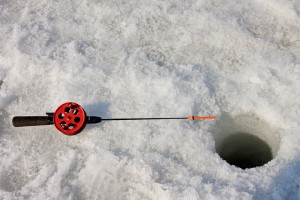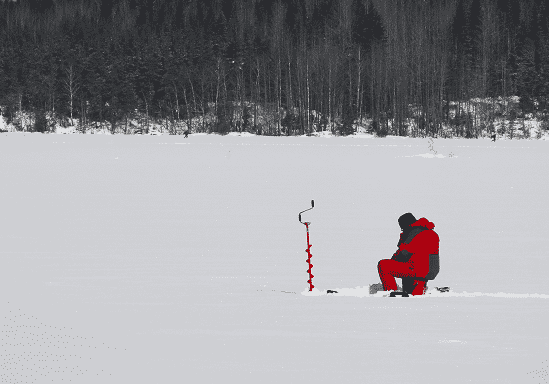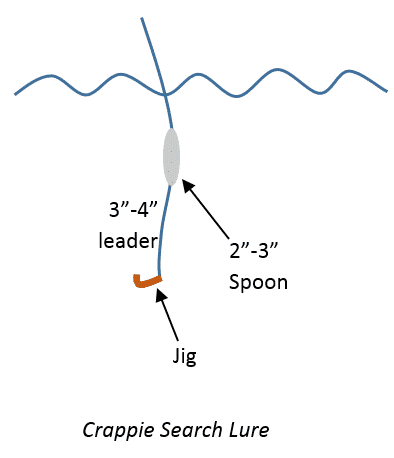
DISCLOSURE: This post may contain affiliate links, meaning when you click the links and make a purchase, I receive a commission. As an Amazon Associate I earn from qualifying purchases.
Ice fishing for crappie can produce a lot of fish when the water freezes in northern parts of the U.S. When winter rolls around, a crappie’s metabolism slows down and they become lethargic. They will be slower and less aggressive than they are during the rest of the year. Not to worry though; if you change your strategy slightly and use the right equipment, ice fishing for crappie can be extremely productive.
Where to Find Winter Crappie
After lakes and reservoirs ice over, the water temperature right under the ice is usually around 32° F. The water near the bottom, on the other hand, is closer to 39° F. This is opposite of what you will observe during other seasons, where the water is warmer near the surface and colder near the bottom. This “inverting” of water temperatures in winter is one of the reasons most baitfish and crappie will move deeper during this time. Most often you will find crappie hanging out in deep water areas where there is contrast in depth and structure. Shelves/drop-offs and deep water holes are two such locations. Note that in shallow lakes (less than 25’ average), crappie may ignore shelves and drop-offs and solely search out deep water holes for warmth.

If there are bays in your lake, chances are there are crappie holding out where the bays open up into the main lake. Bays are usually shallower than the main part of the lake and will freeze first. For this reason, most baitfish will move towards the bay mouths into deeper water when the bays begin to freeze. If the bay mouth is narrow enough, it will act like a funnel which will result in high concentrations of baitfish. These bay mouths can therefore attract large schools of crappie. This is especially true if there is structure (weed beds, sunken trees, drop-offs, etc.) in the bay mouth area.
While deep water is usually the place to begin your search for winter crappie, don’t be afraid to try the shallows too. On many occasions, shallow water weed bed edges (at least 10’ deep) can be great crappie holdouts.
If possible, use a GPS before the lake freezes to find and mark these potential winter crappie areas. This way you can get straight to fishing after the lake freezes over. If you didn’t do this, don’t worry. A flasher/fish-finder can be used to look through the ice to find promising fishing spots. It will work best if the ice is smooth and the fish-finder can get a good seal on the ice. Carry a thermos of hot water and pour some on rough ice to smooth it out enough for the fish-finder to operate. Finding an old hole that is frozen over is an even better option. A contour map of the lake can also be used to find drop-offs and shelves, which are great places to start fishing.
So, what’s the best time of day to go ice fishing for crappie? Well, crappie are largely nocturnal; they feed most actively when it’s dark. There are several studies supporting the idea that crappies primarily feed in low-light conditions, year round. This means dusk to dawn, as well as on cloudy days. This is not to say crappie don’t feed during the day as well, they just prefer darker conditions when most actively feeding. For ice fishing, this means they will most likely be deeper than usual or holding up in structure if it’s a bright day and the ice is clear and free of snow.
Equipment
Ice fishing equipment can differ wildly than regular fishing equipment. The rods are generally shorter, and the reels and lures different. Here’s a breakdown of the common types of equipment used when ice fishing for crappie:
Rod
- Ice fishing rod – Since you won’t be casting when ice fishing for crappie, the extra length of a regular fishing rod is not needed. Ice fishing rods are made specifically for ice fishing. They are short, with a length anywhere from 17”-48”. A length of around 28” is most common for crappie fishing. Ultralight, light, or medium-light power rods are the most typical.
- Regular fishing rod – A regular fishing rod can be used but may be awkward to use if you are in a confined space like an ice shanty. Again, ultralight, light, or medium-light power rods would be most typical here.
Spring Bobbers
- A spring bobber is a short extension that you can add to the tip of your rod. It’s usually made of a spring or similar spring-like material and often has a brightly colored tip. Its main purpose is to better alert the fisherman of even the most subtle strikes and bites. This is especially true of a strike from a fish like the crappie, who usually strikes upwards. This upward striking action is very hard to detect with just a normal rod. Additionally, a spring bobber can dampen the action of an otherwise stiff fishing rod. This can be helpful when trying to better imitate the swimming motion of tiny water insects and baitfish. Here’s an example of a typical spring bobber.
The addition of a spring bobber can make the difference between a slow day and a monster haul.
Reel
- In-line reel – Typically used for fly-fishing, this has become the most suited reel for ice fishing. Unlike spinning and spincasting reels, an in-line reel will not twist your fishing line due to the orientation of its spool. This is its biggest advantage. Twisted line can cause your lure or bait to spin which will most definitely not appeal to a fish. An in-line reel doesn’t have a bail, so you will have to let line out by pulling it from the spool. This may seem like a disadvantage, but by not having to close a bail first you will always be ready to hook a fish if the opportunity arises.
- Spinning reel – These reels are widely used when ice fishing for crappie and are still a great choice.
- Spincast reel – These reels can be a good choice as well due to their simplicity.
- Baitcasting reel – Baitcasting reels, like in-line reels, will not twist your line. You can also let line out with the push of a button. Downsides: usually more expensive than other reel types, they take lots of practice to avoid backlash, and are typically used with heavier (10 lb+) line.
Line
- 2-6 lb test line is commonly used. When fishing around structure, use line closer to 6 lb test. When fishing open water, use line closer to 2 lb test. Mono, fluorocarbon, and braided can all be used and each have their advantages. My personal favorite is fluorocarbon. It is nearly invisible, sensitive, abrasion resistant, strong for its size, and sinks quickly.
Lure/bait
- Jigs – Like during the rest of the year, jigs are always a good choice. Keep it small. Use 1/16, 1/32, 1/48, or 1/64 oz jigs. These will move slower and give the slow winter crappies more of a chance to strike the lure. This Foo Flyer jig is a great place to start.
When using a normal lead jig, use a split shot to get your rig down to the right depth quickly. If using a tungsten jig, which is denser than lead, a split-shot is not necessary. Use slightly heavier tungsten jigs than lead heads to compensate for the lack of a split-shot but still maintain the same jig profile. Lead heads (lead jigs) and tungsten jigs are most often tipped with soft plastics, minnows, or wax worms.
- Minnow – More often than not a small minnow on a size 6, 8 or 10 hook will be the most effective setup
 when ice fishing for crappie. Hook it right under the dorsal fin and spine for better action and more
when ice fishing for crappie. Hook it right under the dorsal fin and spine for better action and more
consistent hooking. Use a small bobber and add a split shot (if not using a tungsten jig) between it and the minnow to complete the rig. - Search lure – When trying to find which depth the crappie are schooling at, a search lure is a great choice. This rig consists of your main line tied to a larger 2”-3” spoon or lure followed by a 3”-4” leader and your jig. The larger lure acts as an attractant. It’s big, bright and noisy and will bring crappie up close. They may not be able to bite the large lure but your small jig will be right behind it ready to be chowed down. After you start catching fish, switch to jigs or minnows.
- Fish finder/flasherA fish finder or flasher isn’t necessary to catch crappie. It can, however, make ice fishing more exciting by providing a visual of what’s going on underwater. It can also, more importantly, help you locate the depth at which the crappie are suspending at. This will allow you to get your bait or lure down to that depth quickly before the crappies leave the area and search somewhere else for food.
Technique
- Jigging – Vertical jigging is the most popular technique used when ice fishing for crappie. Crappie strike upwards, so always be ready when lowering your lure down. When fishing shallower water, start by placing your lure about a foot under the ice. Twitch the tip of your rod a few times and pause for about five seconds. Then, let out about a foot of line and repeat. Alternate small twitches with one foot twitches to imitate small insects and baitfish. If fishing deep water, you can start your lure at about 20 feet off the bottom. Once you get bites or catch a fish you can return to that same depth. When you do find the depth where the crappie are suspended, return your jig down there quickly to catch as many fish as you can before the school moves. After the jig reaches the proper depth though, take your time. Remember, crappie’s metabolism is slower in the winter so they will move slower.
- Minnows – When using minnows, the technique is very similar to vertical jigging. Every so often twitch your line slightly to create movement. After five minutes, let a couple feet of line out if you don’t get any bites. Wait again. Let out another couple feet and so on until you find the depth the fish are suspended at. Once you get bites or catch a fish you can return to that same depth.
- Setting the hook – If using a bobber, make sure it is partially submerged so it pops up if a crappie strikes upward. You can do this most easily by using a smaller bobber (recommended) or adding more weight to your rig. A steady lift is the best method to set the hook in a crappie’s delicate mouth.
- Retrieving – When you are using a reel that is not made to reel in a fish, hand over hand retrieval of the line is necessary. If you are using a standard fly-reel, this will usually need to be done. Regular fishing reels and even newer in-line reels can be reeled. When retrieving the fish always keep tension on the line to prevent the crappie from coming off the hook.
With these tips in mind you should be able to get started ice fishing for crappie. It may be cold and snowy but putting in a few hours on the ice can be a sure fire way to catch winter crappie. After all, can you really wait all the way until spring to start fishing again?

